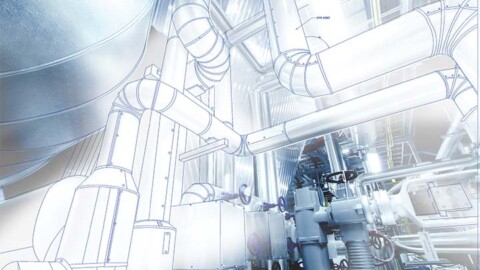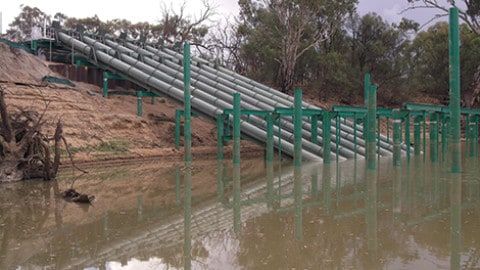Heating, ventilation and air conditioning (HVAC) generally consumes the largest proportion of energy in commercial buildings, typically accounting for around 40 per cent of total building consumption and around 70 per cent of base building electricity consumption. Unlike other energy efficiency strategies such as plant upgrades that can be more expensive, improving the performance of HVAC systems can provide a quick reduction in energy use and costs. Here, we look at some of the ways pumping systems for HVAC services can be optimised.
There are a number of key end uses in HVAC systems where energy consumption occurs which can be further broken down with the national average being:
- 34 per cent of HVAC energy consumption is from fans for air circulation and ventilation
- 27 per cent of energy consumption is from cooling – most frequently the energy use of chillers for cooling via chilled water, but also the use of direct expansion cooling systems such as packaged air conditioners
- 17 per cent of energy consumption is from heating – most frequently the energy use of boilers for hot water for heating, as well as the use of electric heaters for zonal reheat
- 16 per cent of energy consumption is from pumps for the circulation of hot water, chilled water and condenser water
- Six per cent of energy consumption is from cooling towers for heat rejection, being primarily the cooling tower fan energy
HVAC optimisation strategies can vary, but something as simple as changing control algorithms, altering control schedules and set points, and completing minor mechanical repairs and alterations to existing equipment and systems(1).
The before and after energy consumption of an individual end use for some buildings following an efficiency upgrade can vary by a factor of five or more, especially for fans as they are highly non-linear, and gas as it is often very inefficiently used.
However, to realise the benefit, building owners and facility managers need to see energy efficiency strategies as an investment rather than a cost, and implement several strategies at the same time as true optimisation will not be achieved by deploying strategies alone.
Optimising existing fan/pump distribution systems
The first approach to optimising existing distribution systems is to assess it for problems before establishing system pressure and flow rate requirements and quantifying the installed fan or pump capabilities. This process requires system performance data to be collected over time as logging data such as flow rate, discharge pressure and energy consumption is essential for diagnosing optimum system performance.
Many existing fan and pumping systems in HVAC can improve their efficiency and performance by identifying system problems due to incorrect fan or pump selection and operation. Incorrect fan or pump size can be determined by comparing the system pressure/flow requirements with the fan or pump performance curve.
In many cases, the fan or pump performance can be better matched to the system requirements, with maximum efficiency and minimum power consumption achieved by ensuring that the flow and pressure at the fan or pump’s best efficiency point (BEP) closely matches the system operating point.
Where fan or pump distribution systems are not performing optimally, there are a number of solutions that can be explored(2):
- Replace old fans/pumps with modern energy-efficient replacements
- Replace constant volume systems with variable volume systems
- High pressure drop – clean filters/strainers and heat exchangers
- High pressure drop – reduce system resistance by upsizing ducts/pipes and fittings, removing unnecessary fittings, removing throttling dampers/valves and installing low pressure-drop plan
- Oversized fan/pump – trim/change impeller, smaller impeller, VSD, two-speed drive, lower rpm. Undersized fan/pump – replace fan/pump or reduce system resistance (optimise flows)
- Multiple fans/pumps operating continuously – review and update the control system
- High maintenance costs – match fan/pump capacity with system requirements; check materials compatibility (corrosive environment etc.)
- High flow rates – adjust system operating temperatures to maximise temperature differentials and reduce flow rates
- Over throttled system – modify fan/pump performance to reduce the need for throttling
- High power use – rebalance the system to minimise flows and remove throttling
- High distribution losses – review the quantity and quality of the insulation system installed on duct and pipework. Repair defects and upgrade insulation levels to meet contemporary energy standards
- Provide instrumentation to measure pressure, flow and power use
- Repair seals and packing to minimise losses
Optimisation through variable speed controls
A common way of optimising an HVAC pumping system is through the installation of variable speed drives to the fan, pump or compressor motors. There are a number of opportunities for this to be implemented.
Secondary chilled water pumping (differential water rest)
Secondary chilled water (SCHW) pumping systems distribute chilled water (CHW) from the CHW plant room to the various distribution systems such as air handling units (AHUs) and fan coil units (FCUs). Pumping of CHW through chillers is not carried out by the SCHW, rather this is done by the primary CHW pumps.
An optimisation strategy for SCHW pumping systems that have two-port modulating valves and hence a variable flow, is using system differential pressure reset control. Variable secondary chilled water pumping that uses this strategy can minimise the pumping energy required to distribute the chilled water, and can reduce energy consumption by up to 30 per cent.
For a three-port modulating valve (constant flow) system, it will need to be converted to a two-port by modifying the existing valve through shutting down the bypass port or replacing it with two-port valves. The control logic of this optimisation strategy is also applicable to new SCHW systems.
Typically the control of CHW secondary pumps in variable flow distribution circuits is achieved by setting the pump to maintain a constant pressure set point, which is usually selected for the peak design CHW flow. The problem with this is that the pump maintains too high a static pressure most of the time, therefore wasting energy.
For such systems, energy consumption can be reduced during part-load conditions by reducing the speed of the SCHW pump incrementally (CHW pressure set point reset) to maintain an opening of 95 per cent of the most open CHW valve; thereby delivering CHW at the lowest possible pressure while still satisfying the CHW needs of all CHW distribution systems.
Optimised SCHW pumping is typically a cost-effective way to improve energy efficiency of HVAC systems as it requires minimal investment and immediately reduces the energy consumption of the system by reducing its load. However, costs will significantly increase if two-port valves need to be retrofitted.
Variable head pressure control (water-cooled condensers)
The energy efficiency of HVAC systems in part-load conditions can be further improved by controlling the head pressure of water-cooled condensers. This is achieved by installing VSD controllers to pumps to control the head pressure of single water-cooled direct expansion (DX) units, as well as using condenser water (CW) modulating head pressure valves to control head pressure of multiple water-cooled, AC DX units supplied by CW from one CW pump.
This strategy has the potential to reduce the energy consumption of CW pumps by ten to 30 per cent, and improve control and reliability of AC systems during part-load conditions. Typically, water-cooled condensers maintain head pressure by ensuring constant CW flow as per manufacturer’s requirement, or constant CW flow as per HVAC system designer’s requirements.
Both ensure sufficient heat rejection during the hottest O/A conditions; however, they potentially compromise part-load performance of associated AC DX units due to the risk from over-condensing. Furthermore, the additional CW flow results in wasted energy by the CW pump, as often CW continues to circulate through AC units even when they are not in operation.
During lower ambient air temperatures, the AC load typically decreases while the capacity of condensers increases. Therefore energy savings are possible by reducing the condensing pressure of the refrigeration cycle. The reduced pressure can then be maintained by VSD-controlled pumps, resulting in additional energy savings compared to a fixed speed pump.
Variable head pressure control is typically a cost-effective way to improve energy efficiency in HVAC systems. While it does require some investment in new drives, valves and controls, an immediate reduction in energy consumption can be realised by reducing system pump power.
A true optimisation strategy for results
This article covers a few ways that HVAC pumping systems can be optimised, however there are many more strategies that can be implemented across the entire system. In order for HVAC optimisation strategies to save significant energy and money, a three-pronged approach addressing infrastructure design, system automation and optimisation, and ongoing monitoring and maintenance is needed. A system that can automatically respond to the environment will deliver the greatest energy efficiency.
References




















